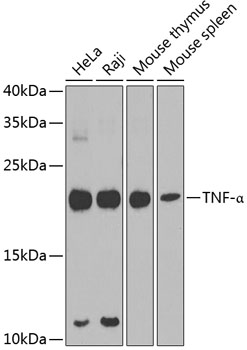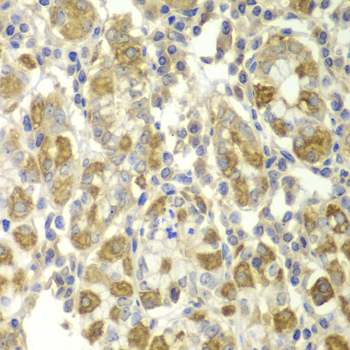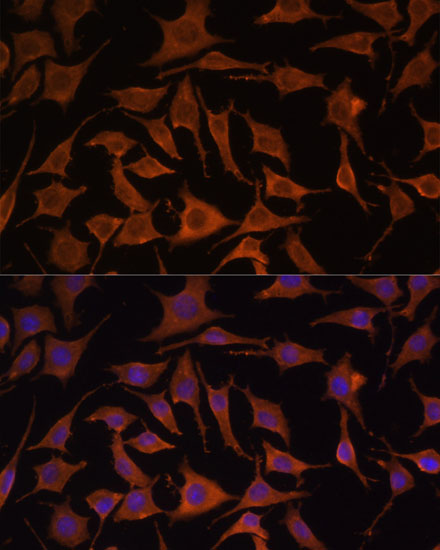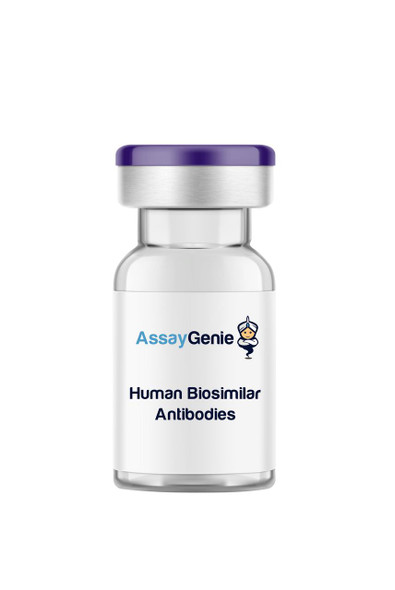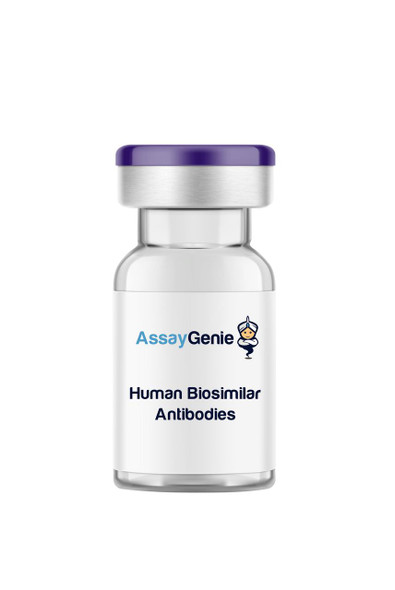Cell Biology Antibodies 2
Anti-TNF-Alpha Antibody (CAB11534)
- SKU:
- CAB11534
- Product Type:
- Antibody
- Reactivity:
- Human
- Reactivity:
- Mouse
- Reactivity:
- Rat
- Host Species:
- Rabbit
- Isotype:
- IgG
- Antibody Type:
- Polyclonal Antibody
- Research Area:
- Cell Biology
Description
| Antibody Name: | Anti-TNF-Alpha Antibody |
| Antibody SKU: | CAB11534 |
| Antibody Size: | 20uL, 50uL, 100uL |
| Application: | WB IHC IF |
| Reactivity: | Human, Mouse, Rat |
| Host Species: | Rabbit |
| Immunogen: | A synthetic peptide of human TNF |
| Application: | WB IHC IF |
| Recommended Dilution: | WB 1:1000 - 1:2000 IHC 1:50 - 1:200 IF 1:50 - 1:100 |
| Reactivity: | Human, Mouse, Rat |
| Positive Samples: | HeLa, Raji, Mouse thymus, Mouse spleen |
| Immunogen: | A synthetic peptide of human TNF |
| Purification Method: | Affinity purification |
| Storage Buffer: | Store at -20'C. Avoid freeze / thaw cycles. Buffer: PBS with 0.02% sodium azide, 50% glycerol, pH7.3. |
| Isotype: | IgG |
| Sequence: | Email for sequence |
| Gene ID: | 7124 |
| Uniprot: | P01375 |
| Cellular Location: | Cell membrane, Membrane, Secreted, Single-pass type II membrane protein, Single-pass type II membrane protein |
| Calculated MW: | 25kDa |
| Observed MW: | 21kDa |
| Synonyms: | TNF, DIF, TNF-alpha, TNFA, TNFSF2, TNLG1F, TNF alpha |
| Background: | This gene encodes a multifunctional proinflammatory cytokine that belongs to the tumor necrosis factor (TNF) superfamily. This cytokine is mainly secreted by macrophages. It can bind to, and thus functions through its receptors TNFRSF1A/TNFR1 and TNFRSF1B/TNFBR. This cytokine is involved in the regulation of a wide spectrum of biological processes including cell proliferation, differentiation, apoptosis, lipid metabolism, and coagulation. This cytokine has been implicated in a variety of diseases, including autoimmune diseases, insulin resistance, and cancer. Knockout studies in mice also suggested the neuroprotective function of this cytokine. |
| UniProt Protein Function: | TNF-a: Cytokine that binds to TNFRSF1A/TNFR1 and TNFRSF1B/TNFBR. It is mainly secreted by macrophages and can induce cell death of certain tumor cell lines. It is potent pyrogen causing fever by direct action or by stimulation of interleukin-1 secretion and is implicated in the induction of cachexia, Under certain conditions it can stimulate cell proliferation and induce cell differentiation. Homotrimer. Interacts with SPPL2B. Belongs to the tumor necrosis factor family. |
| UniProt Protein Details: | Protein type:Membrane protein, integral; Motility/polarity/chemotaxis; Apoptosis; Cytokine Chromosomal Location of Human Ortholog: 6p21.3 Cellular Component: extracellular space; recycling endosome; cell surface; integral to plasma membrane; extracellular region; plasma membrane; external side of plasma membrane; phagocytic cup; lipid raft Molecular Function:identical protein binding; protein binding; protease binding; cytokine activity; tumor necrosis factor receptor binding Biological Process: positive regulation of JNK activity; extracellular matrix organization and biogenesis; positive regulation of nitric oxide biosynthetic process; positive regulation of NFAT protein import into nucleus; activation of MAPK activity; positive regulation of osteoclast differentiation; positive regulation of apoptosis; positive regulation of transcription, DNA-dependent; response to glucocorticoid stimulus; positive regulation of caspase activity; positive regulation of NF-kappaB import into nucleus; osteoclast differentiation; positive regulation of translational initiation by iron; positive regulation of membrane protein ectodomain proteolysis; activation of NF-kappaB transcription factor; positive regulation of MAP kinase activity; tumor necrosis factor-mediated signaling pathway; positive regulation of phagocytosis; negative regulation of interleukin-6 production; JNK cascade; negative regulation of osteoblast differentiation; positive regulation of action potential; regulation of immunoglobulin secretion; embryonic gut development; negative regulation of protein complex disassembly; positive regulation of cytokine production; response to drug; positive regulation of I-kappaB kinase/NF-kappaB cascade; positive regulation of heterotypic cell-cell adhesion; positive regulation of mitosis; response to virus; positive regulation of interleukin-8 biosynthetic process; glucose metabolic process; positive regulation of interleukin-6 production; negative regulation of fat cell differentiation; positive regulation of chemokine production; negative regulation of cytokine secretion during immune response; positive regulation of protein transport; detection of mechanical stimulus involved in sensory perception of pain; cell activation; defense response to Gram-positive bacterium; induction of apoptosis via death domain receptors; DNA damage response, signal transduction resulting in induction of apoptosis; positive regulation of transcription from RNA polymerase II promoter; positive regulation of transcription factor activity; negative regulation of L-glutamate transport; response to activity; negative regulation of transcription, DNA-dependent; skeletal muscle contraction; sequestering of triacylglycerol; positive regulation of smooth muscle cell proliferation; negative regulation of transcription from RNA polymerase II promoter; positive regulation of interleukin-18 production; chronic inflammatory response to antigenic stimulus; response to salt stress; positive regulation of synaptic transmission; positive regulation of hair follicle development; negative regulation of cell proliferation; response to radiation; negative regulation of lipid catabolic process; positive regulation of neuron apoptosis; protein kinase B signaling cascade; lipopolysaccharide-mediated signaling pathway; positive regulation of chronic inflammatory response to antigenic stimulus; inflammatory response; regulation of I-kappaB kinase/NF-kappaB cascade; caspase activation; positive regulation of humoral immune response mediated by circulating immunoglobulin; positive regulation of protein complex disassembly; transformed cell apoptosis; MAPKKK cascade; calcium-mediated signaling; positive regulation of peptidyl-serine phosphorylation; humoral immune response; positive regulation of protein kinase B signaling cascade; positive regulation of interferon-gamma production; negative regulation of glucose import; positive regulation of programmed cell death; positive regulation of chemokine biosynthetic process; positive regulation of protein complex assembly; negative regulation of viral genome replication; protein import into nucleus, translocation; positive regulation of protein kinase activity; response to hypoxia; positive regulation of fever; activation of MAPKKK activity; receptor biosynthetic process; positive regulation of protein amino acid phosphorylation; leukocyte tethering or rolling; negative regulation of myoblast differentiation; regulation of insulin secretion; positive regulation of cytokine secretion Disease: Asthma, Susceptibility To; Migraine With Or Without Aura, Susceptibility To, 1; Malaria, Susceptibility To |
| NCBI Summary: | This gene encodes a multifunctional proinflammatory cytokine that belongs to the tumor necrosis factor (TNF) superfamily. This cytokine is mainly secreted by macrophages. It can bind to, and thus functions through its receptors TNFRSF1A/TNFR1 and TNFRSF1B/TNFBR. This cytokine is involved in the regulation of a wide spectrum of biological processes including cell proliferation, differentiation, apoptosis, lipid metabolism, and coagulation. This cytokine has been implicated in a variety of diseases, including autoimmune diseases, insulin resistance, and cancer. Knockout studies in mice also suggested the neuroprotective function of this cytokine. [provided by RefSeq, Jul 2008] |
| UniProt Code: | P01375 |
| NCBI GenInfo Identifier: | 135934 |
| NCBI Gene ID: | 7124 |
| NCBI Accession: | P01375.1 |
| UniProt Secondary Accession: | P01375,O43647, Q9P1Q2, Q9UIV3, |
| UniProt Related Accession: | P01375 |
| Molecular Weight: | 25,644 Da |
| NCBI Full Name: | Tumor necrosis factor |
| NCBI Synonym Full Names: | tumor necrosis factor |
| NCBI Official Symbol: | TNF |
| NCBI Official Synonym Symbols: | DIF; TNFA; TNFSF2; TNF-alpha |
| NCBI Protein Information: | tumor necrosis factor; TNF-a; cachectin; APC1 protein; TNF, monocyte-derived; TNF, macrophage-derived; tumor necrosis factor-alpha; tumor necrosis factor ligand superfamily member 2 |
| UniProt Protein Name: | Tumor necrosis factor |
| UniProt Synonym Protein Names: | Cachectin; TNF-alpha; Tumor necrosis factor ligand superfamily member 2; TNF-a |
| Protein Family: | Tumor necrosis factor |
| UniProt Gene Name: | TNF |
| UniProt Entry Name: | TNFA_HUMAN |


